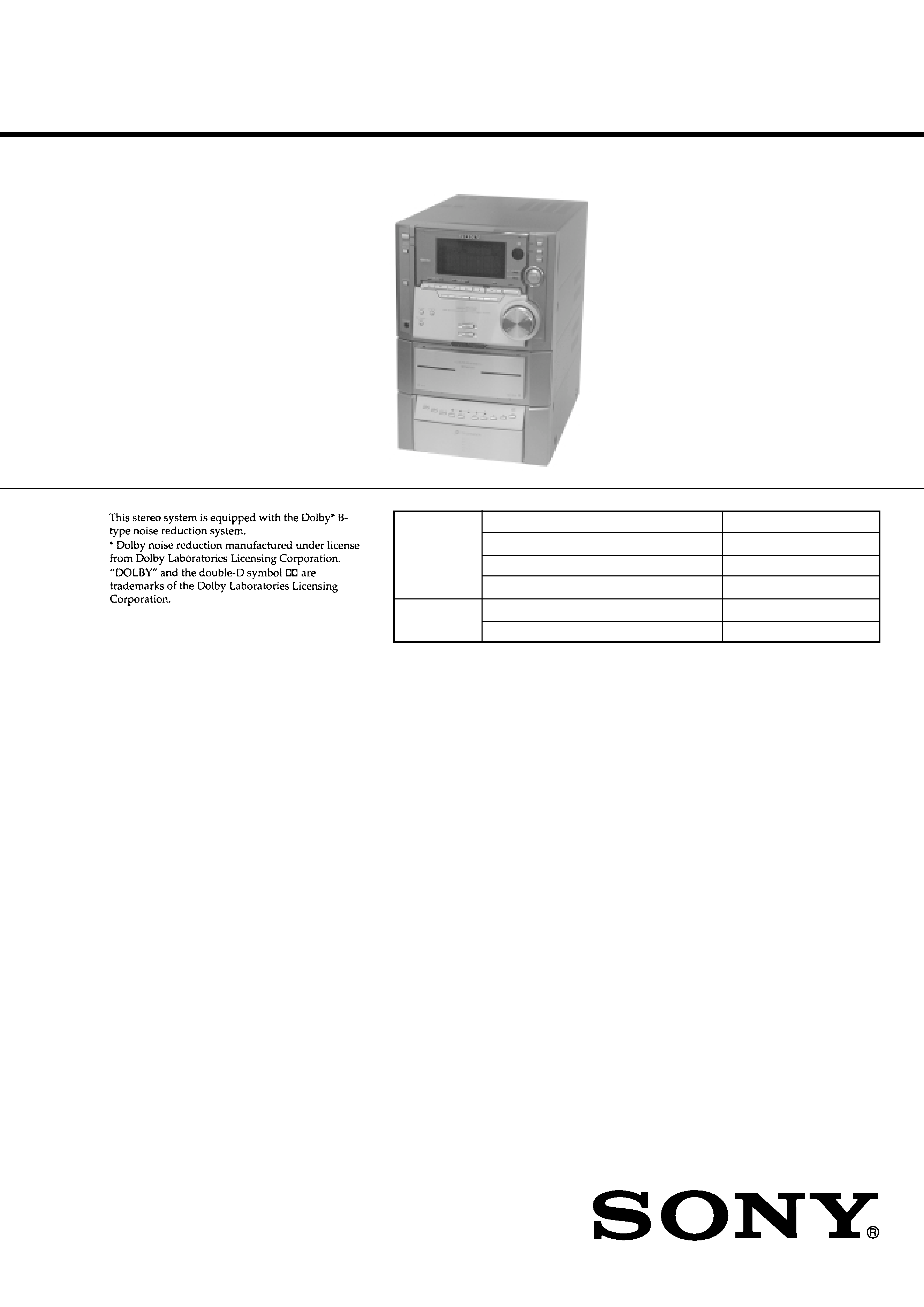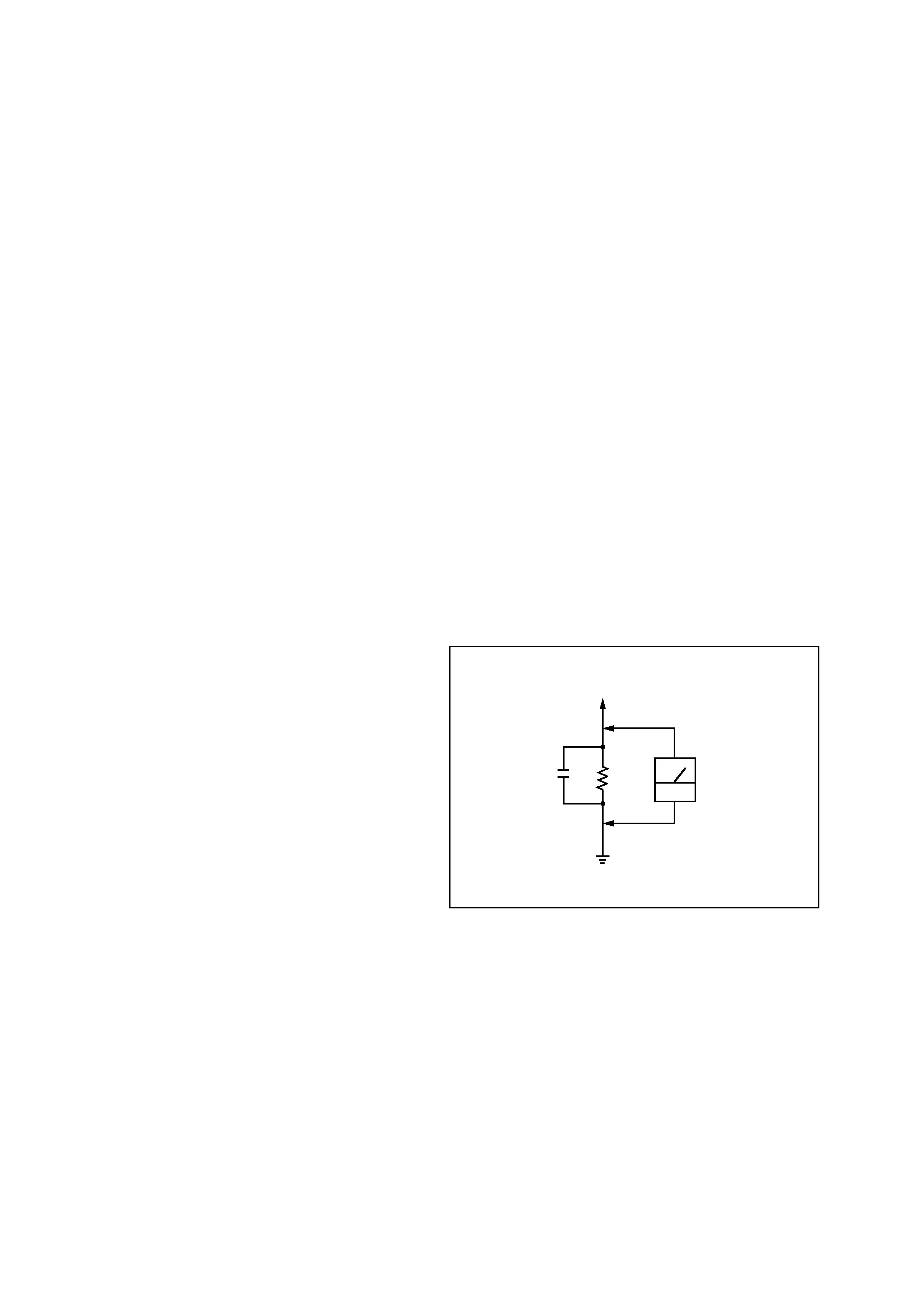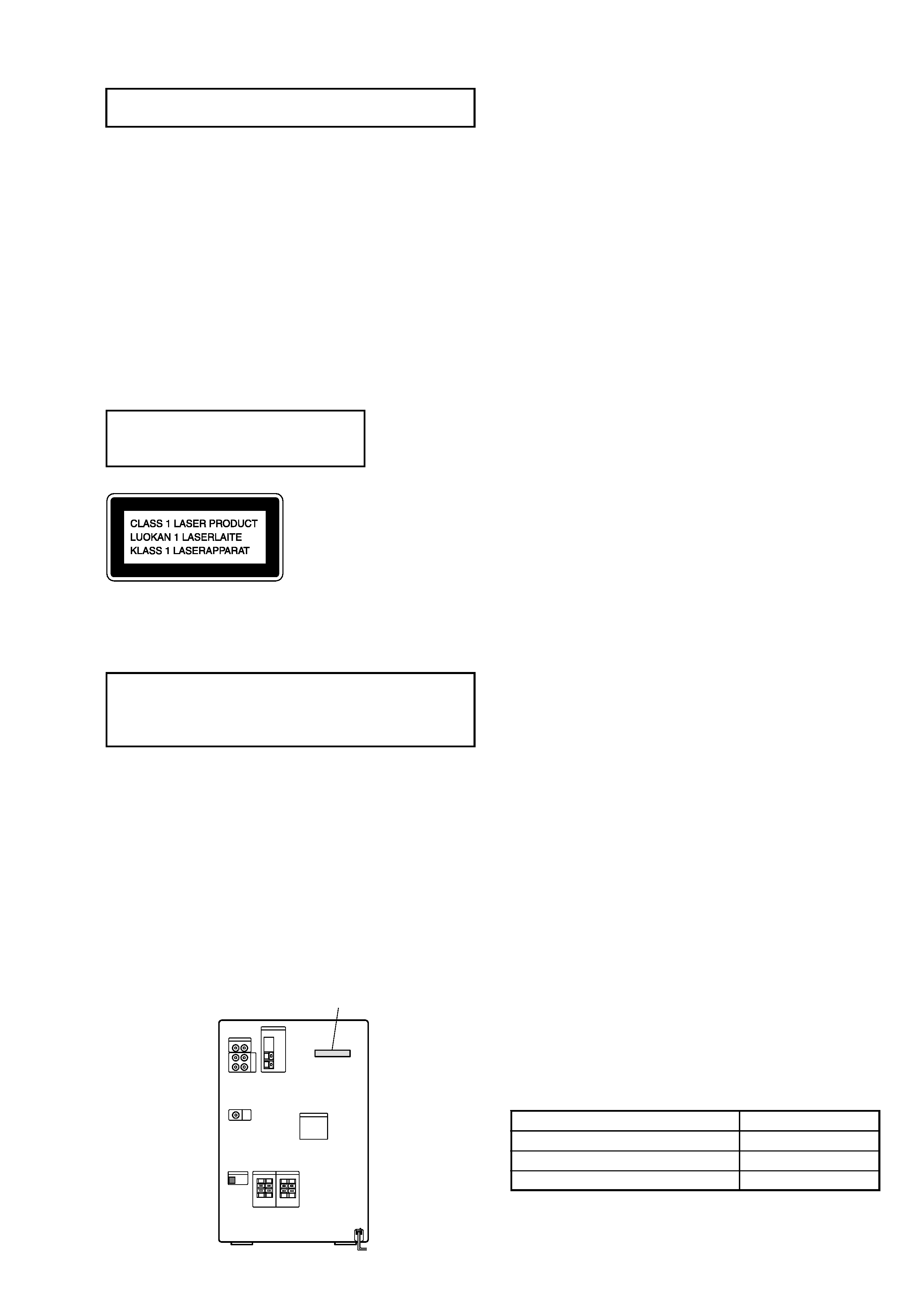
SERVICE MANUAL
Sony Corporation
Audio Entertainment Group
MINI Hi-Fi COMPONENT SYSTEM
2000D001668-1
Printed in Japan ©2000.4
Published by HA Quality Assurance Dept.
9-929-228-11
UC Model
Canadian Model
AEP Model
UK Model
COMPONENT MODEL NAME FOR MHC-ZX10
· MHC-ZX10 is composed of following model.
As for the service manual, it is issued for each component
model,then, please refer to them.
SPEAKER SYSTEM
SS-ZX10
PARTS LIST
Part No.
Description
Remark
ACCESSORIES & PACKING MATERIALS
********************************
1-418-862-11
COMMANDER, STANDARD (RM-SR110)
1-501-374-11
ANTENNA, LOOP
1-501-659-41
ANTENNA (FM)
1-769-306-11
CORD, SPEAKER (1.5m)
4-210-254-11
CUSHION (FOOT) (FRONT SPEAKER)
4-227-887-11
MANUAL, INSTRUCTION (ENGLISH) (US, CND, AEP, UK, CIS)
4-227-887-21
MANUAL, INSTRUCTION (FRENCH) (CND)
4-227-887-31
MANUAL, INSTRUCTION (FRENCH, SPANISH) (AEP)
4-227-887-41
MANUAL, INSTRUCTION (GERMAN) (AEP, G)
4-227-887-51
MANUAL, INSTRUCTION (DUTCH, PORTUGUESE, ITALISH) (AEP)
4-227-887-61
MANUAL, INSTRUCTION (SWEDISH, DANISH, FINNISH) (AED)
4-991-151-41
COVER, BATTERY (FOR RM-SR110)
MHC-ZX10
HCD-ZX10
· Abbreviation
CND
:
Canadian model
G
:
German model
COMPACT DISC DECK
RECEIVER SYSTEM
SPECIFICATIONS
General
Power requirements
North American model:
120 V AC, 60 Hz
European model:
230 V AC, 50/60 Hz
Power consumption
USA model:
190 watts
Canadian model:
195 watts
European model:
200 watts
Dimensions (w/h/d)
Approx. 250 x 375 x 395 mm
Supplied accessories:
AM loop antenna (1)
FM lead antenna (1)
Remote Commander (1)
Batteries (2)
Speaker cable (2)
Front speaker pads (8)
Design and specifications are subject to change without notice.

1
HCD-ZX10
SERVICE MANUAL
HCD-ZX10 is the tuner, deck, CD and amplifier
section in MHC-ZX10.
SPECIFICATIONS
MINI Hi-Fi COMPONENT SYSTEM
-- Continued on next page --
Model Name Using Similar Mechanism
NEW
CD Mechanism Type
CDM53F-K2BD38
Base Unit Type
BU-K2BD38
Optical Pick-up Type
KSM-213DAP/Z-NP
Model Name Using Similar Mechanism
NEW
Tape Transport Mechanism Type
TCM-230AWR12
CD
SECTION
TAPE DECK
SECTION
US Model
Canadian Model
AEP Model
UK Model
Amplifier section
AUDIO POWER SPECIFICATIONS:
(US model only)
POWER OUTPUT AND TOTAL HARMONIC
DISTORTION:
with 8
loads both channels driven, from 120
10,000 Hz; rates 110 W per channel minimum
RMS power, with no more than 10 % total
harmonic distortion from 250 mW to rated output.
Total harmonics distortion Less than 0.07%
(8
at 1 kHz, 60 W)
Canadian model:
Continuous RMS power output (reference)
100 + 100 W
(8
at 1 kHz,
10% THD)
Total harmonics distortion
Less than 0.07%
(8
at 1 kHz, 60 W)
Expect US, Canadian:
DIN power output (rated) 80 + 80 W
(8
at 1 kHz, DIN)
Continuous RMS power output (reference)
100 + 100 W
(8
at 1 kHz,
10% THD)
Music power output (reference)
170 + 170 W
(8
at 1 kHz,
10% THD)
CD player section
System
Compact disc and digital audio
system
Laser
Semiconductor laser
(
=780nm)
Emission duration: continuous
Laser output
Max. 44.6
µW*
*This output is the value measured
at a distance of 200 mm from the
objective lens surface on the
Optical Pick-up Block with 7 mm
aperture.
Wavelength
780 790 nm
Frequency response
2 Hz 20 kHz (
±0.5 dB)
Signal-to-noise ratio
More than 90 dB
Dynamic range
More than 90 dB
Inputs
VIDEO (AUDIO) IN:
voltage 250 mV,
(phono jacks)
impedance 47 k
MD IN:
voltage 450 mV,
(phono jacks)
impedance 47 k
Outputs
MD OUT:
voltage 250 mV
(phono jacks)
impedance 1 k
PHONES:
accepts headphones of
(stereo mini jack)
8
or more
FRONT SPEAKER:
accepts impedance of 8 to 16
SURROUND SPEAKER: accepts impedance of 16
SUPER WOOFER:
Voltage 1 V, impedance 1 k
Tape player section
Recording system
4-track 2-channel stereo
Frequency response
40 13,000 Hz (
±3 dB),
(DOLBY NR OFF)
using Sony TYPE I cassette
40 14,000 Hz (
±3 dB),
using Sony TYPE II cassette
Wow and flutter
±0.15% W.Peak (IEC)
0.1% W.RMS (NAB)
±0.2% W.Peak (DIN)
Tuner section
FM stereo, FM/AM superheterodyne tuner
FM tuner section
Tuning range
US, Canadian models:
87.5 108.0 MHz (100 kHz step)
Other models:
87.5 108.0 MHz (50 kHz step)
Antenna
FM lead antenna
Antenna terminals
75
unbalanced
Intermediate frequency
10.7 MHz
CD OPTICAL DIGITAL OUT
(Square optical connector jack, rear panel)
Wavelength
660 nm
Output Level
18 dBm

2
SAFETY CHECK-OUT
(US model only)
After correcting the original service problem, perform the
following safety checks before releasing the set to the customer:
Check the antenna terminals, metal trim, "metallized" knobs, screws,
and all other exposed metal parts for AC leakage. Check leakage as
described below.
LEAKAGE
The AC leakage from any exposed metal part to earth ground and
from all exposed metal parts to any exposed metal part having a
return to chassis, must not exceed 0.5 mA (500 microampers).
Leakage current can be measured by any one of three methods.
1.
A commercial leakage tester, such as the Simpson 229 or RCA
WT-540A. Follow the manufacturers' instructions to use these
instruments.
2.
A battery-operated AC milliammeter. The Data Precision 245
digital multimeter is suitable for this job.
3.
Measuring the voltage drop across a resistor by means of a
VOM or battery-operated AC voltmeter. The "limit" indication
is 0.75 V, so analog meters must have an accurate low-voltage
scale. The Simpson 250 and Sanwa SH-63Trd are examples of
a passive VOM that is suitable. Nearly all battery operated
digital multimeters that have a 2V AC range are suitable. (See
Fig. A)
Fig. A. Using an AC voltmeter to check AC leakage.
0.15
µF
To Exposed Metal
Parts on Set
1.5k
AC
voltmeter
(0.75V)
Earth Ground
General
Power requirements
US, Canadian models:
120 V AC, 60 Hz
Except US, Canadian models:
230 V AC, 50/60 Hz
Power consumption
US model:
190 W
Canadian model:
195 W
Dimensions (w/h/d)
Approx. 250 x 375 x 395 mm
Mass
US, Canadian models:
Approx. 11.5 kg
Approx. 11.0 kg
Except US, Canadian models:
Supplied accessories:
AM loop antenna (1)
FM lead antenna (1)
Remote Commander (1)
Batteries (2)
Speaker cords (2)
Front speaker pads (8)
Design and specifications are subject to change
without notice.
European model:
200 W
AM tuner section
Tuning range
US, Canadian models:
530 1,710 kHz
(with the interval set at
10 kHz)
531 1,710 kHz
(with the interval set at
9 kHz)
Except US, Canadian models:
531 1,602 kHz
(with the interval set at
9 kHz)
Antenna
AM loop antenna
Antenna terminals
External antenna terminal
Intermediate frequency
450 kHz
SAFETY-RELATED COMPONENT WARNING!!
COMPONENTS IDENTIFIED BY MARK 0 OR DOTTED LINE WITH
MARK 0 ON THE SCHEMATIC DIAGRAMS AND IN THE PARTS
LIST ARE CRITICAL TO SAFE OPERATION. REPLACE THESE
COMPONENTS WITH SONY PARTS WHOSE PART NUMBERS
APPEAR AS SHOWN IN THIS MANUAL OR IN SUPPLEMENTS
PUBLISHED BY SONY.
ATTENTION AU COMPOSANT AYANT RAPPORT
À LA SÉCURITÉ!
LES COMPOSANTS IDENTIFÉS PAR UNE MARQUE 0 SUR LES
DIAGRAMMES SCHÉMATIQUES ET LA LISTE DES PIÈCES SONT
CRITIQUES POUR LA SÉCURITÉ DE FONCTIONNEMENT. NE
REMPLACER CES COMPOSANTS QUE PAR DES PIÈSES SONY
DONT LES NUMÉROS SONT DONNÉS DANS CE MANUEL OU
DANS LES SUPPÉMENTS PUBLIÉS PAR SONY.

3
This appliance is classified as a CLASS 1 LASER product. The
CLASS 1 LASER PRODUCT MARKING is located on the rear
exterior.
Laser component in this product is capable
of emitting radiation exceeding the limit for
Class 1.
CAUTION
Use of controls or adjustments or performance of procedures
other than those specified herein may result in hazardous radiation
exposure.
Notes on chip component replacement
· Never reuse a disconnected chip component.
· Notice that the minus side of a tantalum capacitor may be
damaged by heat.
Flexible Circuit Board Repairing
· Keep the temperature of soldering iron around 270°C
during repairing.
· Do not touch the soldering iron on the same conductor of the
circuit board (within 3 times).
· Be careful not to apply force on the conductor when soldering
or unsoldering.
NOTES ON HANDLING THE OPTICAL PICK-UP
BLOCK OR BASE UNIT
The laser diode in the optical pick-up block may suffer electrostatic
break-down because of the potential difference generated by the
charged electrostatic load, etc. on clothing and the human body.
During repair, pay attention to electrostatic break-down and also
use the procedure in the printed matter which is included in the
repair parts.
The flexible board is easily damaged and should be handled with
care.
NOTES ON LASER DIODE EMISSION CHECK
The laser beam on this model is concentrated so as to be focused on
the disc reflective surface by the objective lens in the optical pick-
up block. Therefore, when checking the laser diode emission,
observe from more than 30 cm away from the objective lens.
MODEL IDENTIFICATION
-- BACK PANEL --
TABLE OF CONTENTS
1. GENERAL ·········································································· 4
2. DISASSEMBLY
2-1.
Case ···················································································· 7
2-2.
Front Panel Section ···························································· 7
2-3.
Tape Mechanism Deck Section (TCM-230AWR12) ·········· 8
2-4.
Back Panel Section ····························································· 8
2-5.
Main Board, Front AMP Board ·········································· 9
2-6.
CD Base Unit (BU-K2BD38) ············································· 9
2-7.
CD Mechanism Deck Section (CDM53F-K2BD38) ········ 10
2-8.
Fitting Base (Guide) Assy, Bracket (Chassis) and
Fitting Base (Magnet) Assy ·············································· 10
2-9.
Tray (Sub) ········································································· 11
2-10. Chassis (Mold B) Section, Stocker Section and
Slider (Selection) ······························································ 11
2-11. Gears Installation ······························································ 12
2-12. Slider (Selection) Installation ··········································· 12
2-13. Stocker Section Installation ·············································· 13
2-14. Chassis (Mold B) Section Installation ······························ 13
3. TEST MODE ···································································· 14
4. MECHANICAL ADJUSTMENTS ····························· 18
5. ELECTRICAL ADJUSTMENTS ······························· 18
6. DIAGRAMS
6-1.
Circuit Board Location ····················································· 23
6-2.
Block Diagrams ································································ 24
6-3.
Printed Wiring Board BD Section ······························ 28
6-4.
Schematic Diagram BD Section ································· 29
6-5.
Printed Wiring Board Deck Section ··························· 30
6-6.
Schematic Diagram Deck Section ······························ 31
6-7.
Printed Wiring Board Main Section ··························· 32
6-8.
Schematic Diagram Main (1/3) Section ····················· 33
6-9.
Schematic Diagram Main (2/3) Section ····················· 34
6-10. Schematic Diagram Main (3/3) Section ····················· 35
6-11. Printed Wiring Board AMP Section ··························· 36
6-12. Schematic Diagram AMP Section ······························ 37
6-13. Printed Wiring Board Panel Section ··························· 38
6-14. Schematic Diagram Panel Section ····························· 39
6-15. Printed Wiring Board Switch Section ······················· 40
6-16. Schematic Diagram Switch Section ··························· 41
6-17. Printed Wiring Board CD Mechanism Section ·········· 42
6-18. Schematic Diagram CD Mechanism Section ············· 43
6-19. Printed Wiring Board Power Supply Section ············· 44
6-20. Schematic Diagram Power Supply Section ················ 45
6-21. Printed Wiring Board Leaf SW Section ····················· 46
6-22. Schematic Diagram Leaf SW Section ························ 46
6-23. IC Block Diagrams ··························································· 47
6-24. IC Pin Descriptions ·························································· 50
7. EXPLODED VIEWS
7-1.
Back Panel Section ··························································· 54
7-2.
Front Panel Section ·························································· 55
7-3.
Chassis Section ································································· 56
7-4.
CD Mechanism Deck Section-1 (CDM53F-K2BD38) ···· 57
7-5.
CD Mechanism Deck Section-2 (CDM53F-K2BD38) ···· 58
7-6.
Base Unit Section (BU-K2BD38A) ································· 59
7-7.
Tape Mechanism Deck Section (TCM-230AWR12) ········ 60
8. ELECTRICAL PARTS LIST ······································· 61
· Abbreviation
CND : Canadian model
AED
: North European model
G
: German model
Parts No.
MODEL
US model
CND model
AEP, G, AED, UK, CIS models
PARTS No.
4-226-747-0s
4-226-747-1s
4-226-747-2s

4
SECTION 1
GENERAL
1
?/1 button and indicator
2
TAPE A h button and indicator
3
TAPE A H button and indicator
4
TAPE B h button and indicator
5
TAPE B H button and indicator
6
x button
7
CD indicator
8
SOUND MODE indicator
9
SET UP MODE indicator
q;
CINEMA SPACE button and indicator
qa
V-GROOVE button and indicator
qs
MODE SELECT button
qd
PUSH ENTER button/Multi stick
qf
TUNER/BAND button
qg
u button
qh
VOLUME knob
qj
Z 1 to Z 5 buttons
qk
DISC 1 to DISC 5 buttons
ql
PHONES jack
w;
FUNCTION button
wa
DISPLAY button
ws
TIMER SELECT indicator
wd
. button
wf
> button
wg
m button
wh
M button
wj
GROOVE EX button
wk
GROOVE button
wl
TAPE B Z button
e;
DISC 1 to DISC 5 indicator
ea
TAPE A Z button
es
REC PAUSE/START button
ed
HI-DUB button
ef
CD SYNC button
12
wd wf wg wh
3 4 5 6 789
ef
es
ed
qk
ql
w;
ws
wa
0
qd
qh
qg
qf
qa
qs
qj
e;
wj
wk
wl
ea
